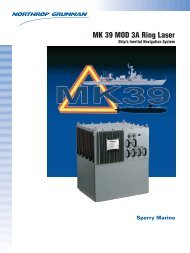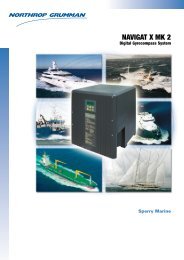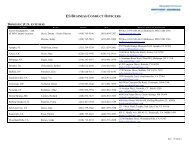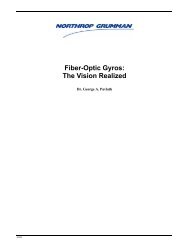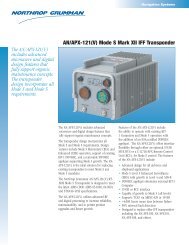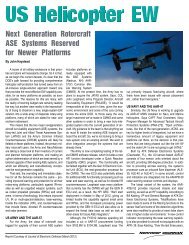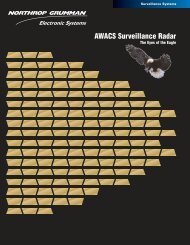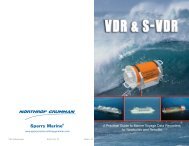Northrop Grumman's Family of Fiber-Optic Based Inertial Navigation ...
Northrop Grumman's Family of Fiber-Optic Based Inertial Navigation ...
Northrop Grumman's Family of Fiber-Optic Based Inertial Navigation ...
You also want an ePaper? Increase the reach of your titles
YUMPU automatically turns print PDFs into web optimized ePapers that Google loves.
Commercial Applications<br />
NSD is also bringing the advantages <strong>of</strong> fi beroptic<br />
gyro technology to the commercial aircraft<br />
navigation market with the LTN-101E <strong>Inertial</strong><br />
Reference System. Of extreme importance in this<br />
market is the very high reliability and long life that<br />
fi ber-optics technology brings compared to current<br />
ring laser gyro technology. The LTN-101E provides<br />
highly reliable velocity and attitude information<br />
for the aircraft. The LTN-101E subassemblies are<br />
shown in Figure 9.<br />
The system is composed <strong>of</strong> the sensor assembly,<br />
power supply, HIRF/Lightning module, processor,<br />
air data, and the module that mixes with the external<br />
GPS inertial data. The LTN-101E sensor assembly<br />
uses the same fi ber-optic gyro technology as the<br />
LN-251; however, the gyros are screened specifi -<br />
cally for the export market and mounted on a sensor<br />
block that precludes the use <strong>of</strong> the LTN-101E<br />
in high dynamic military applications.<br />
Future Improvements<br />
The geolocation problem is pushing the requirements<br />
for positional accuracies. NSD has been investigating<br />
the use <strong>of</strong> differential GPS corrections<br />
8<br />
Figure 9 – LTN-101E Subassemblies<br />
in the LN-251 and LN-260 to provide the user with<br />
the most accurate positional information possible.<br />
DGPS is the process in which corrections are applied<br />
to the GPS signal to compensate errors in the<br />
broadcast GPS signal. These errors are composed<br />
<strong>of</strong> errors in the knowledge <strong>of</strong> the position <strong>of</strong> the<br />
GPS satellite and errors in the satellites, onboard<br />
clock, as well as atmospheric disturbances that corrupt<br />
the GPS signal in the local area. In the standard<br />
operation <strong>of</strong> GPS, the receiver derives positional<br />
information by interpreting the timing data on the<br />
signal and the broadcast location <strong>of</strong> the satellite. In<br />
differential GPS, the differential reference receiver<br />
knows its location very precisely and thus can invert<br />
the normal process and derive equivalent timing<br />
errors on the signal by comparing the known and<br />
derived locations. These timing errors are a result<br />
<strong>of</strong> dynamic conditions in the ionosphere which can<br />
change quite rapidly as well as errors in the GPS<br />
satellite clock and orbit information which change<br />
quite slowly. Accordingly these errors have to be<br />
continuously derived and provided back to the roving<br />
GPS receiver to compensate for errors created<br />
by the atmospheric conditions, both in the ionosphere<br />
and the troposphere and satellite errors. In<br />
the most simple <strong>of</strong> DGPS approaches the errors<br />
are treated as a lump sum whereas in the more so-



